Casio EX-F1 User Manual
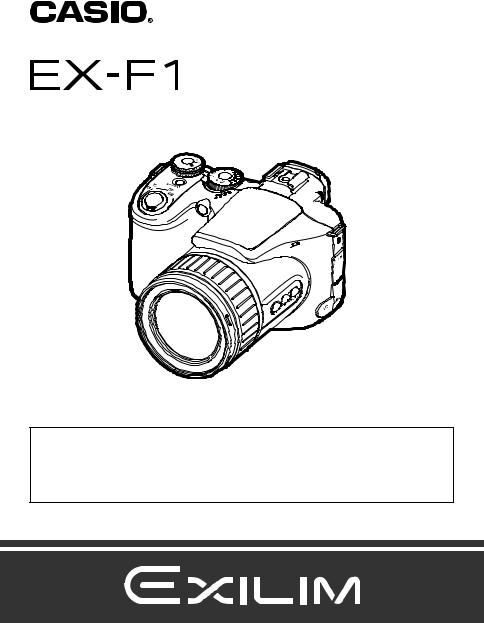
E
Digital Camera
User’s Guide
K860PCM1DMX
Thank you for purchasing this CASIO product.
•Before using it, be sure to read the precautions contained in this User’s Guide.
•Keep the User’s Guide in a safe place for future reference.
•For the most up-to-date information about this product, visit the official EXILIM Website at http://www.exilim.com/
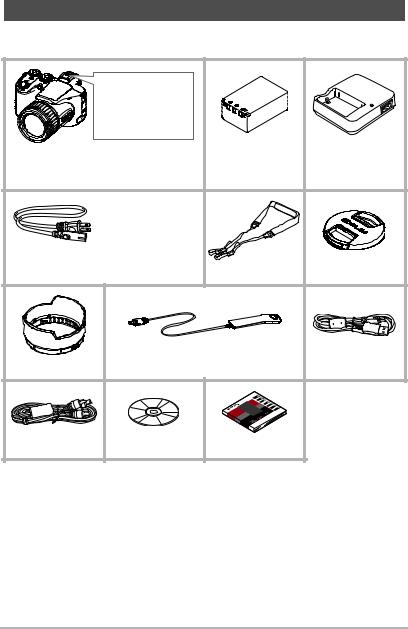
Unpacking
As you unpack your camera, check to make sure that all items shown below are included. If anything is missing, contact your original retailer.
• A shoe cap is installed on the hot shoe at the factory.
|
Rechargeable |
Charger unit |
|
Digital camera |
lithium ion battery |
||
(BC-100L) |
|||
|
(NP-100) |
||
|
|
•The shape of the power cord plug
varies according to country or geographic area.
Power cord |
|
Strap |
Lens cap |
Lens hood |
Remote shutter release |
USB cable |
|
AV cable |
CD-ROM |
Basic Reference |
|
2

Read this first!
•The contents of this manual are subject to change without notice.
•The contents of this manual have been checked at each step of the production process. Feel free to contact us if you notice anything that is questionable, erroneous, etc.
•Any copying of the contents of this User’s Guide, either in part or its entirety, is forbidden. Except for your own personal use, any other use of the contents of this manual without the permission of CASIO COMPUTER CO., LTD. is forbidden under copyright laws.
•CASIO COMPUTER CO., LTD. shall not be held liable for any damages or lost profits suffered by you or any third party due to the use or malfunction of this product.
•CASIO COMPUTER CO., LTD. shall not be held liable for any damages, lost profits, or claims by third parties arising out of the use of ArcSoft TotalMedia Extreme for CASIO, ArcSoft TotalMedia Theatre for CASIO, ArcSoft TotalMedia Studio for CASIO, or YouTube Uploader for CASIO.
•CASIO COMPUTER CO., LTD. shall not be held liable for any damages or lost profits caused by loss of memory contents due to malfunction, repair, or any other reason.
•Note that the example screens and product illustrations shown in this User’s Guide may differ somewhat from the screens and configuration of the actual camera.
LCD Panel
The liquid crystal panel used for the monitor screen and viewfinder employs highprecision technology that provides a pixel yield of 99.99%. This means that some very small number of pixels may not light or may remain lit at all times. This is due to the characteristics of the liquid crystal panel, and does not indicate malfunction.
Take test shots
Before shooting your final image, shoot a test shot to ensure that the camera is recording correctly.
3

Contents
Unpacking . . . . . . . . . . . . . . . . . . . . . . . . . . . . . . . . . . . . . . . . . . . . . . . . . . . . 2 Read this first! . . . . . . . . . . . . . . . . . . . . . . . . . . . . . . . . . . . . . . . . . . . . . . . . . 3
Quick Start Basics |
9 |
What is a digital camera? . . . . . . . . . . . . . . . . . . . . . . . . . . . . . . . . . . . . . . . . 9 What you can do with your CASIO camera . . . . . . . . . . . . . . . . . . . . . . . . . . 10 Attaching the Lens Cap and Strap . . . . . . . . . . . . . . . . . . . . . . . . . . . . . . . . . 11 First, charge the battery prior to use.. . . . . . . . . . . . . . . . . . . . . . . . . . . . . . . 11
To charge the battery . . . . . . . . . . . . . . . . . . . . . . . . . . . . . . . . . . . . . . . . . . . . . 11To load the battery . . . . . . . . . . . . . . . . . . . . . . . . . . . . . . . . . . . . . . . . . . . . . . . 13
Configuring the Display Language the First Time You Turn On the Camera. . 15 Preparing a Memory Card . . . . . . . . . . . . . . . . . . . . . . . . . . . . . . . . . . . . . . . 16
Supported Memory Cards. . . . . . . . . . . . . . . . . . . . . . . . . . . . . . . . . . . . . . . . . . 16To load a memory card . . . . . . . . . . . . . . . . . . . . . . . . . . . . . . . . . . . . . . . . . . . . 16To format (initialize) a new memory card . . . . . . . . . . . . . . . . . . . . . . . . . . . . . . 17
To shoot a snapshot. . . . . . . . . . . . . . . . . . . . . . . . . . . . . . . . . . . . . . . . . . . . 18 Holding the Camera Correctly . . . . . . . . . . . . . . . . . . . . . . . . . . . . . . . . . . . . 20 Viewing Snapshots . . . . . . . . . . . . . . . . . . . . . . . . . . . . . . . . . . . . . . . . . . . . 21 Deleting Images. . . . . . . . . . . . . . . . . . . . . . . . . . . . . . . . . . . . . . . . . . . . . . . 22
To delete a single file . . . . . . . . . . . . . . . . . . . . . . . . . . . . . . . . . . . . . . . . . . . . . 22To delete all files . . . . . . . . . . . . . . . . . . . . . . . . . . . . . . . . . . . . . . . . . . . . . . . . . 22
Snapshot Shooting Precautions . . . . . . . . . . . . . . . . . . . . . . . . . . . . . . . . . . 23
Auto Focus Restrictions . . . . . . . . . . . . . . . . . . . . . . . . . . . . . . . . . . . . . . . . . . . 23
Turning the Camera On and Off . . . . . . . . . . . . . . . . . . . . . . . . . . . . . . . . . . 24
To turn power on . . . . . . . . . . . . . . . . . . . . . . . . . . . . . . . . . . . . . . . . . . . . . . . . . 24To turn off the camera . . . . . . . . . . . . . . . . . . . . . . . . . . . . . . . . . . . . . . . . . . . . . 24
Snapshot Tutorial |
25 |
Selecting a Recording Mode . . . . . . . . . . . . . . . . . . . . . . . . . . . . . . . . . . . . . 25 Using the Control Panel. . . . . . . . . . . . . . . . . . . . . . . . . . . . . . . . . . . . . . . . . 28 Changing the Image Size . . . . . . . . . . . . . . . . . . . . . . . . . . . . . . . . (Size) . . 29 Using Flash . . . . . . . . . . . . . . . . . . . . . . . . . . . . . . . . . . . . . . . . . . .(Flash) . . 31 Specifying ISO Sensitivity . . . . . . . . . . . . . . . . . . . . . . . . . . . . . . . . . (ISO) . . 34 Adjusting White Balance . . . . . . . . . . . . . . . . . . . . . . . . . (White Balance) . . 34 Correcting Image Brightness . . . . . . . . . . . . . . . . . . . . . . . . . . .(EV Shift) . . 36 Specifying the Metering Mode . . . . . . . . . . . . . . . . . . . . . . . . . (Metering) . . 37 Specifying the Auto Focus Area . . . . . . . . . . . . . . . . . . . . . . . . (AF Area) . . 37 Shooting with the REC Light . . . . . . . . . . . . . . . . . . . . . . . . . . (REC Light) . . 39 Changing the Control Panel Date/Time Style . . . . . . . . . . . . . . . . . . . . . . . . 39 Shooting with Zoom . . . . . . . . . . . . . . . . . . . . . . . . . . . . . . . . . . . . . . . . . . . . 40
Optical Zoom/Digital Zoom Switch Point. . . . . . . . . . . . . . . . . . . . . . . . . . . . . . . 41
Selecting a Focus Mode . . . . . . . . . . . . . . . . . . . . . . . . . . . . . . . . (Focus) . . 43 Correcting for Back Lighting . . . . . . . . . . . . . . . . . . . . . . . . . . . . . . . . . . . . . 45 Locking the Auto Exposure and Auto Focus Setting . . . . . . . . . . . . . . . . . . . 45
B |
4 |
Contents |
|

Specifying the [AE-L/AF-L] button Operation . . . . . . . . . . . . . . . . . . . . . . . . . . . 45
Using Continuous Shutter . . . . . . . . . . . . . . . . . . . . . . . . . . . . . . . . . . . . . . . 46
Selecting the Continuous Shutter (CS) Mode . . . . . . . . . . . . . . . . . . . . . . . . . . . 46Using Flash Continuous Shutter . . . . . . . . . . . . . . . . . . . . . . . . . . . . . . . . . . . . . 48Using Prerecord (Still image) . . . . . . . . . . . . . . . . . . . . . . . . . . . . . . . . . . . . . . . 50Using High-speed Continuous Shutter . . . . . . . . . . . . . . . . . . . . . . . . . . . . . . . . 52Shooting with Slow Motion View . . . . . . . . . . . . . . . . . . . . . . . . . . . . . . . . . . . . . 53Shooting with Bracketing Continuous Shutter. . . . . . . . . . . . . . . . . . . . . . . . . . . 54Specifying the Method for Saving Continuous Shutter Images. . . . . . . . . . . . . . 58Continuous Shutter Precautions . . . . . . . . . . . . . . . . . . . . . . . . . . . . . . . . . . . . . 60
Recording Movies |
62 |
To record a movie . . . . . . . . . . . . . . . . . . . . . . . . . . . . . . . . . . . . . . . . . . . . . 62
Audio. . . . . . . . . . . . . . . . . . . . . . . . . . . . . . . . . . . . . . . . . . . . . . . . . . . . . . . . . . 63
Movie Mode Settings . . . . . . . . . . . . . . . . . . . . . . . . . . . . . . . . . . . . . . . . . . . 64
Recording a High-definition Movie . . . . . . . . . . . . . . . . . . . . . . . . . . . . . . . . . . . 64Recording a High-speed Movie. . . . . . . . . . . . . . . . . . . . . . . . . . . . . . . . . . . . . . 65
Shooting a Snapshot while Shooting a Movie . . . . . . . . . . . . . . . . . . . . . . . . 66
Using BEST SHOT |
67 |
What is BEST SHOT? . . . . . . . . . . . . . . . . . . . . . . . . . . . . . . . . . . . . . . . . . . 67
Some Sample Scenes . . . . . . . . . . . . . . . . . . . . . . . . . . . . . . . . . . . . . . . . . . . . 67
To shoot with BEST SHOT . . . . . . . . . . . . . . . . . . . . . . . . . . . . . . . . . . . . . . 67
Creating Your Own BEST SHOT Setups . . . . . . . . . . . . . . . . . . . . . . . . . . . . . . 69
Shooting with Digital Anti Shake . . . . . . . . . . . . . . . . . (Digital Anti Shake) . . 70 Shooting with Digital Panning . . . . . . . . . . . . . . . . . . . . . (Digital Panning) . . 71 Shooting an Image in Accordance with
Subject Movement . . . . . . . . . . . . . . . . . . . . (Move Out CS/Move In CS) . . 72
Advanced Settings |
|
77 |
Using On-screen Menus . . . . . . . . . . . . . . . . . . . . . . . . |
. . . . . . . . . . . . . . |
. . 77 |
REC Mode Settings . . . . . . . . . . . . . . . . . . . . . . . . . . . . |
. . . . . . . . (REC) |
. . 79 |
Using the Self-timer . . . . . . . . . . . . . . . . . . . . . . . . . . . . . |
. . . . . (Self-timer). |
. . 79 |
Using the Auto Focus Assist Light . . . . . . . . . . . . . . . . . . |
.(AF Assist Light). |
. . 80 |
Reducing the Effects of Camera and Subject Movement |
. . . . (Anti Shake). |
. . 81 |
Shooting with Face Detection . . . . . . . . . . . . . . . . . . . . . |
.(Face Detection). |
. . 82 |
Shooting with Continuous Auto Focus . . . . . . . . . . . . . . . |
. (Continuous AF). |
. . 83 |
Specifying the [AE-L/AF-L] button Operation . . . . . . . . . . |
. . . (AE/AF Lock). |
. . 83 |
Shooting with AE Bracketing . . . . . . . . . . . . . . . . . . . . . . |
. (AE Bracketing). |
. . 83 |
Shooting with White Balance Bracketing . . . . . . . . . . . . . |
.(WB Bracketing). |
. . 83 |
Shooting with Focus Bracketing . . . . . . . . . . . . . . . . . . . |
(Focus Bracketing). |
. . 84 |
Turning Digital Zoom On or Off . . . . . . . . . . . . . . . . . . . . |
. . .(Digital Zoom). |
. . 84 |
Shooting with Quick Shutter . . . . . . . . . . . . . . . . . . . . . . . |
. .(Quick Shutter). |
. . 84 |
Assigning a Function to the Function Ring . . . . . . . . . . . |
. . . . (Ring Setup). |
. . 85 |
Configuring the Continuous Shutter Image Save Method (Save CS Images) |
. . 85 |
|
Turning on Image Review . . . . . . . . . . . . . . . . . . . . . . . . |
. . . . . . . (Review). |
. . 85 |
Displaying the On-screen Grid . . . . . . . . . . . . . . . . . . . . . |
. . . . . . . . . (Grid). |
. . 86 |
Configuring Power On Default Settings . . . . . . . . . . . . . . |
. . . . . . (Memory). |
. . 86 |
5 |
Contents |
|

Image Quality Settings . . . . . . . . . . . . . . . . . . . . . |
. . . . . . . . . . . (Quality) . . |
87 |
Specifying Snapshot Image Quality . . . . . . . . . . . . |
(T Quality (Snapshot)). . . |
87 |
Configuring HD Movie Settings . . . . . . . . . . . . . . . |
. . . . . . (HD » Quality). . . |
87 |
Setting the High-speed Movie Frame Rate . . . . . . |
. . . . . . (HS » Speed). . . |
88 |
Reducing Underexposure and Overexposure . . . . |
. . . . . (Dynamic Range). . . |
88 |
Specifying Flash Intensity . . . . . . . . . . . . . . . . . . . |
. . . . . . (Flash Intensity). . . |
89 |
Turning On Flash Assist . . . . . . . . . . . . . . . . . . . . . |
. . . . . . . . (Flash Assist). . . |
89 |
Using Built-in Color Filters . . . . . . . . . . . . . . . . . . . |
. . . . . . . . . (Color Filter). . . |
89 |
Controlling Image Sharpness . . . . . . . . . . . . . . . . . |
. . . . . . . . . (Sharpness). . . |
90 |
Controlling Color Saturation . . . . . . . . . . . . . . . . . . |
. . . . . . . . . (Saturation). . . |
90 |
Adjusting Image Contrast . . . . . . . . . . . . . . . . . . . . |
. . . . . . . . . . . (Contrast). . . |
90 |
Using the Remote Shutter Release . . . . . . . . . . . . . . . . . . . . . . . . . . . . . . . . 91 Using an External Flash. . . . . . . . . . . . . . . . . . . . . . . . . . . . . . . . . . . . . . . . . 92 Installing the Lens Hood or a Lens Filter . . . . . . . . . . . . . . . . . . . . . . . . . . . . 94
Installing the Lens Hood . . . . . . . . . . . . . . . . . . . . . . . . . . . . . . . . . . . . . . . . . . . 94Installing a Filter . . . . . . . . . . . . . . . . . . . . . . . . . . . . . . . . . . . . . . . . . . . . . . . . . 95
Viewing Snapshots and Movies |
96 |
Viewing Snapshots . . . . . . . . . . . . . . . . . . . . . . . . . . . . . . . . . . . . . . . . . . . . 96 Viewing a Movie. . . . . . . . . . . . . . . . . . . . . . . . . . . . . . . . . . . . . . . . . . . . . . . 96 Viewing Continuous Shutter Images . . . . . . . . . . . . . . . . . . . . . . . . . . . . . . . 97
Deleting Continuous Shutter Images . . . . . . . . . . . . . . . . . . . . . . . . . . . . . . . . . 99Dividing Up a CS Group . . . . . . . . . . . . . . . . . . . . . . . . . . . . . . . . . . . . . . . . . . . 99Copying a CS Group Image . . . . . . . . . . . . . . . . . . . . . . . . . . . . . . . . . . . . . . . 100
Zooming an On-screen Image . . . . . . . . . . . . . . . . . . . . . . . . . . . . . . . . . . . 101 Displaying 12 Images on the Same Screen. . . . . . . . . . . . . . . . . . . . . . . . . 101 Viewing Snapshots and Movies on a TV Screen. . . . . . . . . . . . . . . . . . . . . 102
Viewing High-quality Movies on a Hi-Vision Television . . . . . . . . . . . . . . . . . . . 104
Other Playback Functions |
(PLAY) 106 |
|
Playing a Slideshow on the Camera . . . . . . . . . . . . . . . |
. . . . . (Slideshow) . 106 |
|
Creating a Snapshot of Movie Frames . . . . . . . . . . . . . |
(MOTION PRINT) . 107 |
|
Editing a Movie on the Camera . . . . . . . . . . . . . . . . . . |
. . (Movie Editing) . 108 |
|
Adjusting White Balance . . . . . . . . . . . . . . . . . . . . . . . . |
. (White Balance) . |
110 |
Adjusting the Brightness of an Existing Snapshot . . . . |
. . . . .(Brightness) . |
.111 |
Selecting Images for Printing . . . . . . . . . . . . . . . . . . . . |
. (DPOF Printing) . |
.111 |
Protecting a File Against Deletion . . . . . . . . . . . . . . . . . |
. . . . . . . (Protect) . |
112 |
Rotating an Image . . . . . . . . . . . . . . . . . . . . . . . . . . . . |
. . . . . . (Rotation) . |
113 |
Resizing a Snapshot . . . . . . . . . . . . . . . . . . . . . . . . . . . |
. . . . . . . .(Resize) . |
113 |
Cropping a Snapshot . . . . . . . . . . . . . . . . . . . . . . . . . . |
. . . . . .(Trimming) . 114 |
|
Copying Files . . . . . . . . . . . . . . . . . . . . . . . . . . . . . . . . |
. . . . . . . . . (Copy) . |
114 |
Dividing Up a Continuous Shutter Group . . . . . . . . . . . |
. . .(Divide Group) . |
115 |
Selecting the PLAY Mode Screen Layout . . . . . . . . . . . |
. (Display Layout) . 115 |
|
Copying a Continuous Shutter Group . . . . . . . . . . . . . . |
. . (Select Frame) . 115 |
|
6 |
Contents |
|

Printing |
116 |
Printing Snapshots. . . . . . . . . . . . . . . . . . . . . . . . . . . . . . . . . . . . . . . . . . . . 116 Connecting Directly to a PictBridge Compatible Printer . . . . . . . . . . . . . . . 117 Using DPOF to Specify Images to be Printed and the Number of Copies. . 119
Using the Camera with a Computer |
122 |
Things you can do using a computer... . . . . . . . . . . . . . . . . . . . . . . . . . . . . 122 Using the Camera with a Windows Computer . . . . . . . . . . . . . . . . . . . . . . . 123
Viewing and Storing Images on a Computer. . . . . . . . . . . . . . . . . . . . . . . . . . . 124Playing Back and Saving Movies to Disc . . . . . . . . . . . . . . . . . . . . . . . . . . . . . 126Uploading Movie Files to YouTube . . . . . . . . . . . . . . . . . . . . . . . . . . . . . . . . . . 127Viewing User Documentation . . . . . . . . . . . . . . . . . . . . . . . . . . (PDF Files). . 129User Registration . . . . . . . . . . . . . . . . . . . . . . . . . . . . . . . . . . . . . . . . . . . . . . . 129
Using the Camera with a Macintosh . . . . . . . . . . . . . . . . . . . . . . . . . . . . . . 130
Connecting the Camera to Your Computer and Saving Files . . . . . . . . . . . . . . 130Transferring Images Automatically and Managing Them on Your Macintosh. . 132Playing a Movie. . . . . . . . . . . . . . . . . . . . . . . . . . . . . . . . . . . . . . . . . . . . . . . . . 133Viewing User Documentation . . . . . . . . . . . . . . . . . . . . . . . . . . . (PDF Files). . 133User Registration . . . . . . . . . . . . . . . . . . . . . . . . . . . . . . . . . . . . . . . . . . . . . . . 133
Files and Folders . . . . . . . . . . . . . . . . . . . . . . . . . . . . . . . . . . . . . . . . . . . . . 134 Memory Card Data . . . . . . . . . . . . . . . . . . . . . . . . . . . . . . . . . . . . . . . . . . . 135
Other Settings |
(Set Up) 137 |
Adjusting Monitor Screen Brightness . . . . . . . . . . . . . . . . . . . . . (Screen) . 137 Adjusting Viewfinder Brightness . . . . . . . . . . . . . . . . . . .(EVF Brightness) . 137 Configuring Camera Sound Settings . . . . . . . . . . . . . . . . . . . . . (Sounds) . 138 Specifying the File Name Serial Number Generation Rule . . . . . (File No.) . 138 Configuring World Time Settings . . . . . . . . . . . . . . . . . . . . . (World Time) . 139 Time Stamping Snapshots . . . . . . . . . . . . . . . . . . . . . . . . . . (Timestamp) . 140 Setting the Camera’s Clock . . . . . . . . . . . . . . . . . . . . . . . . . . . . . (Adjust) . 140 Specifying the Date Style . . . . . . . . . . . . . . . . . . . . . . . . . . . . (Date Style) . 141 Specifying the Display Language . . . . . . . . . . . . . . . . . . . . . . (Language) . 141 Configuring Sleep State Settings . . . . . . . . . . . . . . . . . . . . . . . . . (Sleep) . 142 Configuring Auto Power Settings . . . . . . . . . . . . . . . . . . (Auto Power Off) . 142 Configuring [r] and [p] Settings . . . . . . . . . . . . . . . . . . . (REC/PLAY) . 143 Controlling Monitor Screen Priority . . . . . . . . . . . . . . . . . . . (LCD Priority) . 143 Configuring USB Protocol Settings . . . . . . . . . . . . . . . . . . . . . . . . . (USB) . 144 Selecting the Screen Aspect Ratio and Video Output System (Video Out) . 144 Selecting the HDMI Terminal Output Method . . . . . . . . . . .(HDMI Output) . 145 Formatting Built-in Memory or a Memory Card . . . . . . . . . . . . . . (Format) . 145 Resetting the Camera to Factory Defaults . . . . . . . . . . . . . . . . . . (Reset) . 145
7 |
Contents |
|

Configuring Monitor Screen Settings |
146 |
Turning Display Information On and Off . . . . . . . . . . . . . . . . . . . . . . (Info) . 146 Selecting Monitor Screen and Viewfinder Settings . . . . . . . . . . . . . . . . . . . 146 Using the On-screen Histogram to Check Exposure . . . . . . (+Histogram) . 147
How to Use the Histogram . . . . . . . . . . . . . . . . . . . . . . . . . . . . . . . . . . . . . . . . 148
Appendix |
149 |
Precautions during Use . . . . . . . . . . . . . . . . . . . . . . . . . . . . . . . . . . . . . . . . 149 Power Supply. . . . . . . . . . . . . . . . . . . . . . . . . . . . . . . . . . . . . . . . . . . . . . . . 157
Charging . . . . . . . . . . . . . . . . . . . . . . . . . . . . . . . . . . . . . . . . . . . . . . . . . . . . . . 157To replace the battery . . . . . . . . . . . . . . . . . . . . . . . . . . . . . . . . . . . . . . . . . . . . 158Battery Precautions. . . . . . . . . . . . . . . . . . . . . . . . . . . . . . . . . . . . . . . . . . . . . . 158Using the Camera in another Country . . . . . . . . . . . . . . . . . . . . . . . . . . . . . . . 159Using Household Power . . . . . . . . . . . . . . . . . . . . . . . . . . . . . . . . . . . . . . . . . . 159
Using a Memory Card . . . . . . . . . . . . . . . . . . . . . . . . . . . . . . . . . . . . . . . . . 160
To replace the memory card . . . . . . . . . . . . . . . . . . . . . . . . . . . . . . . . . . . . . . . 160
Computer System Requirements for Bundled Software . . . . . . . . . . . . . . . 162 General Guide . . . . . . . . . . . . . . . . . . . . . . . . . . . . . . . . . . . . . . . . . . . . . . . 163 Monitor Screen Contents . . . . . . . . . . . . . . . . . . . . . . . . . . . . . . . . . . . . . . . 165 Reset Initial Default Settings . . . . . . . . . . . . . . . . . . . . . . . . . . . . . . . . . . . . 168 When things don’t go right... . . . . . . . . . . . . . . . . . . . . . . . . . . . . . . . . . . . . 170
Troubleshooting . . . . . . . . . . . . . . . . . . . . . . . . . . . . . . . . . . . . . . . . . . . . . . . . 170Display Messages. . . . . . . . . . . . . . . . . . . . . . . . . . . . . . . . . . . . . . . . . . . . . . . 174
Number of Snapshots and Movie Recording Time . . . . . . . . . . . . . . . . . . . 177 Specifications. . . . . . . . . . . . . . . . . . . . . . . . . . . . . . . . . . . . . . . . . . . . . . . . 180
8 |
Contents |
|
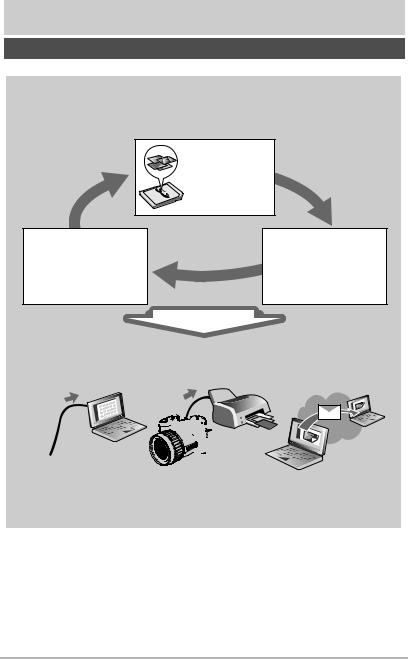
Quick Start Basics
What is a digital camera?
A digital camera stores images on a memory card, so you can record and delete images a countless number of times.
Record |
Delete |
Play |
You can use the images you record in a variety of different ways.
Store images on your |
Print images. |
Attach images to e-mail. |
computer. |
|
|
9 |
Quick Start Basics |
|
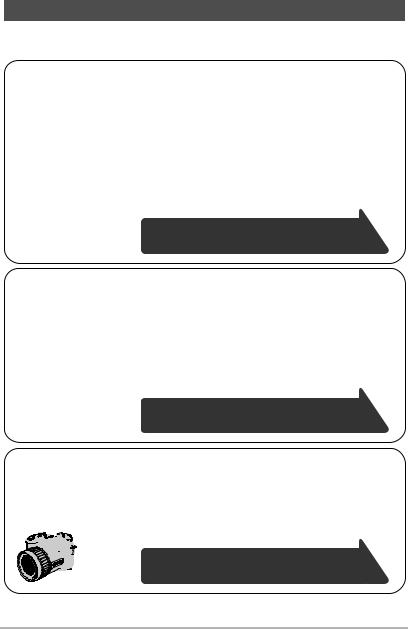
What you can do with your CASIO camera
Your CASIO camera is packed with a powerful selection of features and functions to make recording of digital images easier, including the following three main functions.
High-speed Continuous Shutter Prerecord (Still image)
Now you can shoot continuous high-resolution images at the amazing speed of 60 images per second. Prerecord (Still image) pre-records images to ensure you are almost never too late with the shutter button.
See page 46 for more information.
High-speed Movies
Movies can be recorded at up to 1200 frames per second. This makes it possible to clearly view phenomena that are invisible to the human eye, in slow motion.
See page 64 for more information.
Full HD Movie Recording
You can record movies in high-quality full HD and play them back on a Hi-Vision TV.
(1920x1080 pixels 60 fields/s)
See page 64 for more information.
10 |
Quick Start Basics |
|
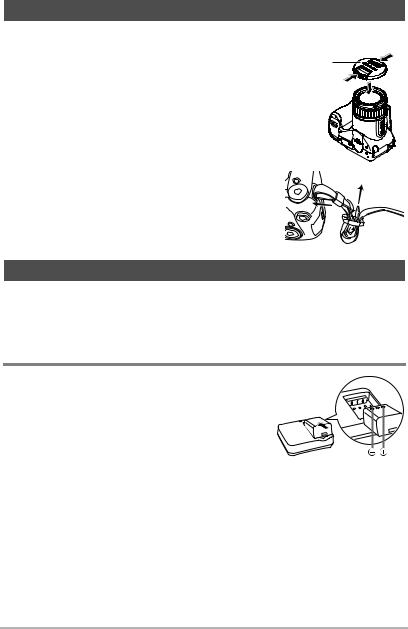
Attaching the Lens Cap and Strap
Be sure to attach the lens cap and strap to the camera before using it.
. Attaching the Lens Cap |
Lens cap |
|
. Attaching the strap
• Attach either end of the strap to the two strap rings on the sides of the camera as shown in the illustration.
• After you are finished pull on the strap to test it and to make sure it does not come loose.
First, charge the battery prior to use.
Note that the battery of a newly purchased camera is not charged. Perform the steps under “To charge the battery” to bring the battery to a full charge.
•Your camera requires a special CASIO rechargeable lithium ion battery (NP-100) for power. Never try to use any other type of battery.

 To charge the battery
To charge the battery
1.Aligning the positive + and negative - terminals of the battery with those of the
charger unit, load the battery into the charger unit.
11 |
Quick Start Basics |
|

2. Plug the charger unit into a household |
[CHARGE] lamp |
||
power outlet. |
|
|
|
About 4 hours 30 minutes are required to |
|
||
reach full charge. The [CHARGE] lamp will |
|
||
light green when charging is complete. |
|
||
Unplug the power cord from the power |
|
||
outlet and then remove the battery from the charger. |
|
||
Lamp Status |
Description |
|
|
Lit Red |
Charging |
|
|
Off |
Charger unit or battery problem due to abnormally high or |
||
low ambient temperature (page 157) |
|||
|
|||
Lit green |
Charging complete or standing by |
|
|
Other Charging Precautions
•Charge the battery in an area where the temperature is within the range of 5°C to 35°C (41°F to 95°F). Outside this temperature range charging can take longer than normal or even fail.
•Use the special charger (BC-100L) to charge the special lithium ion battery (NP-100). Never use any other type of charger device. Attempting to use a different charger can result in unexpected accident.
•A battery that is still warm due to normal use may not charge fully. Give the battery time to cool before charging it.
•A battery discharges slightly even when it is not loaded in the camera. Because of this, it is recommended that you charge the battery immediately before you need to use it.
•Charging the camera’s battery may cause interference with TV and radio reception. If this happens, plug the charger into an outlet that is further away from the TV or radio.
•Actual charging time depends on current battery capacity and charging conditions.
B |
12 |
Quick Start Basics |
|
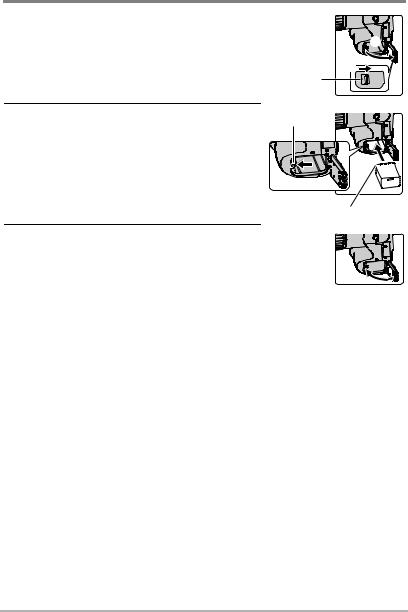

 To load the battery
To load the battery
1. Open the battery cover. |
|
Slide the lock in the direction indicated by the |
|
arrow and the battery cover will open. |
2 |
2.Load the battery.
While holding the stopper to the side in the direction indicated by the arrow, slide the battery into the camera, terminals end first. Press the battery in until the stopper secures it in place.
3.Close the battery cover.
•For information about how to replace the battery, see page 158.
1
Lock
Stopper
Terminals
13 |
Quick Start Basics |
|

Checking Remaining Battery Power
As battery power is consumed, a battery indicator on the monitor screen indicates remaining power as shown below.
Remaining Power |
|
High |
|
|
Low |
|
|
|
|||
Battery Indicator |
|
* |
|
* |
* |
Indicator Color |
Cyan |
* Amber |
* Red |
* Red |
|
|
|
|
|
|
|
 indicates battery power is low. Charge the battery as soon as possible. Recording is not possible when
indicates battery power is low. Charge the battery as soon as possible. Recording is not possible when  is indicated. Charge the battery immediately.
is indicated. Charge the battery immediately.
•The level shown by the battery indicator may change when you switch between the REC mode and PLAY mode.
•Leaving the camera for about one day with no power supplied while the battery is dead will cause its date and time settings to be cleared. You will have to reconfigure the settings after power is restored.
•See page 183 for information about battery life and memory capacity.
Battery Power Conservation Tips
•When you do not need to use the flash, select ? (flash off) for the flash setting (page 31).
•Enable the Auto Power Off and the Sleep features to protect against wasting battery power when you forget to turn off the camera (pages 142, 142).
14 |
Quick Start Basics |
|
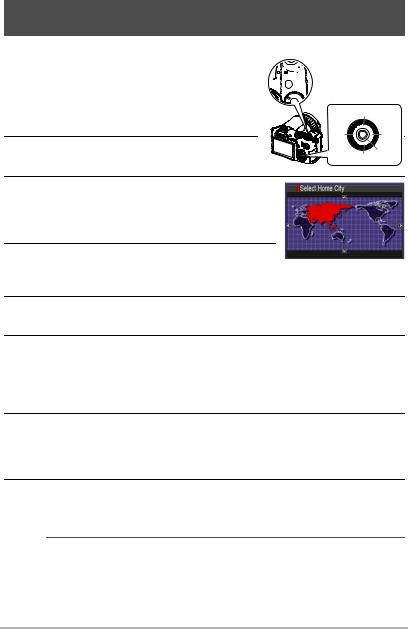
Configuring the Display Language the First Time You Turn On the Camera
The first time you load a battery into the camera, a screen appears for configuring the display language, date, and time settings. Failure to set the date and time correctly will cause the wrong date and time data to be recorded with images.
1.Press [ON/OFF] to turn on the camera.
2.Use [8], [2], [4], and [6] to select the language you want and then press [SET].

 [ON/OFF] (Power)
[ON/OFF] (Power)
=8?
=4?  =6? =2? [SET]
=6? =2? [SET]
3.Use [8], [2], [4], and [6] to select the area where you will be using the camera and then press [SET].
The selected area is highlighted in red.
4.Use [8] and [2] to select the city where you will be using the camera and then press [SET].
5.Use [8] and [2] to select the summer time (DST) setting you want and then press [SET].
6.Use [8] and [2] to select a date style and then press [SET].
Example: 19. 12. 09 YY/MM/DD * 09/12/19 DD/MM/YY * 19/12/09 MM/DD/YY * 12/19/09
7.Set the date and the time.
Use [4] and [6] to select the setting you want to change and then use [8] and [2] to change it.
To switch between 12-hour and 24-hour format, press [DISP].
8.Press [SET].
•If you make a mistake, you can change the settings later (pages 140, 141).
 NOTE
NOTE
•Each country controls its local time offset and the use of summer time, and so they are subject to change.
15 |
Quick Start Basics |
|
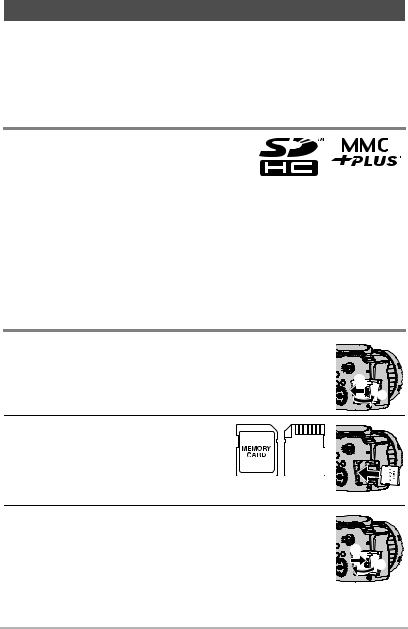
Preparing a Memory Card
Though the camera has built-in memory that can be used to store images and movies, you probably will want to purchase a commercially available memory card for greater capacity. The camera does not come with a memory card. Images recorded while a memory card is loaded are saved to the memory card. When no memory card is loaded, images are saved to built-in memory.
• For information about memory card capacities, see page 177.

 Supported Memory Cards
Supported Memory Cards
– SD Memory Card
– SDHC Memory Card
– MMC (MultiMediaCard)
– MMCplus (MultiMediaCardplus)
Use one of the above types of memory card.
. Memory Card Handling Precautions
Certain types of cards can slow down processing speeds. In particular, you may experience problems saving high-quality movies. Use of certain types of memory cards increase the time it takes to record movies, which can cause movie frames to be lost. The “0 REC” indicator on the monitor screen turns yellow to indicate that frames are being lost. Use of a memory card with a maximum transfer speed of at least 10MB per second is recommended.

 To load a memory card
To load a memory card
1.Press [ON/OFF] to turn off the camera and then open the memory card slot cover.
Pressing the memory card slot cover, slide it in the direction |
1 |
||
indicated by the arrow. |
|
|
|
|
|
2 |
|
|
|
|
|
2. Load a memory card. |
|
|
|
Positioning the memory card so its front is |
|
|
|
facing in the same direction as the |
|
|
|
monitor screen side of the camera, slide it |
|
|
|
into the card slot as far as it will go, until |
Front |
Back |
|
you hear it click securely into place. |
|
||
|
|
|
|
3. Close the memory card slot cover.
Pressing the memory card slot cover against the camera, slide |
|
|
it closed. |
2 |
|
• For information about how to replace the memory card, see |
||
1 |
||
page 160. |
||
|
16 |
Quick Start Basics |
|

 IMPORTANT!
IMPORTANT!
•Never insert anything besides a supported memory card (page 16) into the memory card slot.
•Should water or any foreign object ever get into the card slot, immediately turn off the camera, remove the battery, and contact your retailer or nearest CASIO authorized service center.

 To format (initialize) a new memory card
To format (initialize) a new memory card
You need to format a new memory card before using it for the first time.
1.Turn on the camera and press [MENU].
2.Select the “Set Up” tab, select “Format” and then press [6].
3.Use [8] and [2] to select “Format” and then press [SET].
 IMPORTANT!
IMPORTANT!
•Formatting a memory card that already has snapshots or other files on it, will delete its contents. Normally you do not need to format a memory card again. However, if storing to a card has slowed down or if you notice any other abnormality, re-format the card.
•Be sure to use the camera to format a memory card. Formatting a memory card on a computer and then using it in the camera can slow down data processing by the camera. In the case of an SD or SDHC memory card, formatting on a computer can result in non-conformity with the SD format, causing problems with compatibility, operation, etc.
17 |
Quick Start Basics |
|
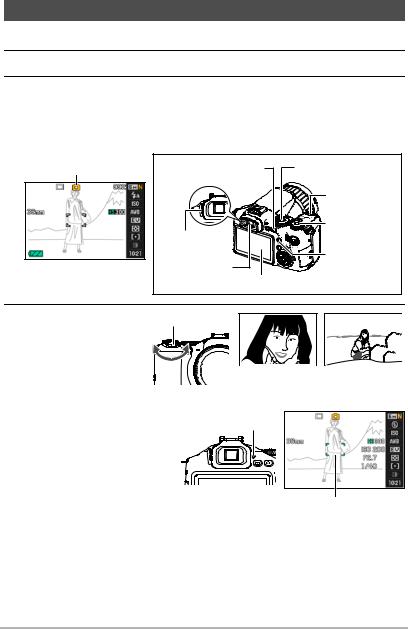
To shoot a snapshot
1.Remove the lens cap and then press [r] (REC) to turn on the camera.
2.Set the mode dial to t (Auto).
3.Set the CS dial to t (Single Shot).
•You can use either monitor screen or viewfinder to compose the image. Each press of the [EVF/LCD] button cycles through the available monitor screen and viewfinder on/off settings (page 146). If the image in the viewfinder appears blurry, use the diopter dial to adjust it.
Snapshot mode icon |
[r] (REC) |
CS dial |
|
|
Shutter button |
|
|
Mode dial |
|
Diopter dial |
|
|
Viewfinder |
[EVF/LCD] |
|
|
|
|
Monitor screen |
|
4.Point the camera at the subject.
You can zoom the image, if you want.
Zoom controller
z Telephoto w Wide Angle
5. Half-press the shutter |
Back lamp |
|
button to focus the image. |
||
|
When focus is complete, the camera will beep, the back lamp will light green, and the focus frame will turn green.
Focus frame
18 |
Quick Start Basics |
|
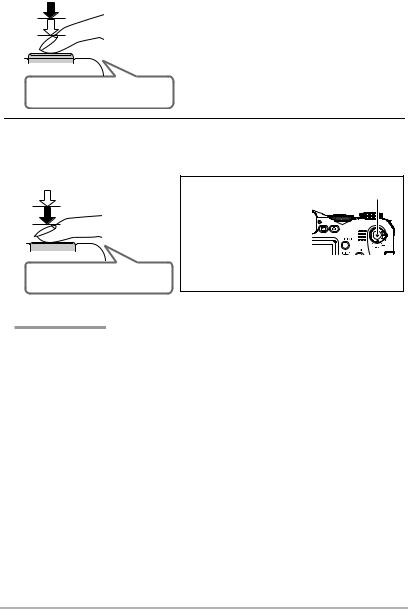
Half-press
Press lightly until the button stops.
Beep, beep (Image is in focus.)
When you half-press the shutter button, the camera automatically adjusts exposure and focuses on the subject it is currently pointed at. Mastering how much pressure is required for a half-press and a full-press of the shutter button is an important technique for goodlooking images.
6.Continuing to keep the camera still, press the shutter button the rest of the way down.
This records the snapshot.
Full-press
Shooting a Movie |
[0] |
Press [0] to start movie |
|
recording. Press [0] |
|
again to stop movie |
|
recording. See page 62 |
|
for details. |
|
Snap (Image is recorded.)
 IMPORTANT!
IMPORTANT!
•While the “Anti Shake” setting is “D Auto” or “A Camera AS”, half pressing the shutter will cause the camera to vibrate and emit an operation sound. This is normal and does not indicate malfunction (page 81).
. Using Quick Shutter
Fully pressing the shutting button without waiting for Auto Focus to operate will record using Quick Shutter (page 84).
•With Quick Shutter, the camera focuses faster than normal Auto Focus, which means you can capture quick moving action more easily. Note, however, that some images may be out of focus when Quick Shutter is used.
•Whenever possible, take a little extra time to half-press the shutter button in order to ensure proper focus.
. If the image does not focus...
If the focus frame stays red and the back lamp is flashing green, it means that the image is not in focus (because the subject is too close, etc.) Point the camera at the subject and try to focus again.
19 |
Quick Start Basics |
|
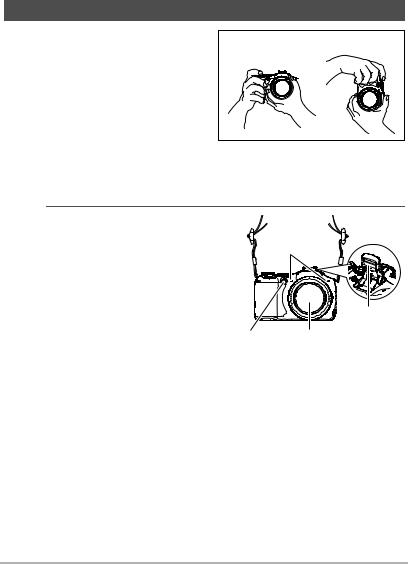
. If the subject is not in the center of the frame...
“Focus lock” (page 44) is the name of a technique you can use when you want to shoot an image in which the subject to be focused on is not within the focus frame in the center of the screen.
Holding the Camera Correctly
Your images will not come out clearly if you |
Horizontal |
Vertical |
move the camera when you press the |
||
shutter button. When pressing the shutter |
|
|
button, be sure to hold the camera as |
|
|
shown in the illustration near by, and keep it |
|
|
still by pressing your arms firmly against |
|
|
your sides as you shoot. |
|
|
Holding the camera still, carefully press the |
|
|
shutter button and take care to avoid all |
|
|
movement as the shutter releases and for a
few moments after it releases. This is especially important when available lighting is low, which slows down the shutter speed.
 NOTE
NOTE
•Take care that your fingers and the strap do not cover any of the areas indicated in the illustration.
•To protect against accidentally dropping the camera, attach the strap and make sure it is around your neck while you are operating the camera.
•Never swing the camera around by its strap.
•The supplied strap is intended for use with this camera only. Never use it for any other purpose.
 Strap
Strap
Microphones
Flash
Front lamp |
Lens |
20 |
Quick Start Basics |
|

Viewing Snapshots
Use the following procedure to view snapshots on the camera’s monitor screen.
•For information about how to play back movies, see page 96.
•For information about images recorded using continuous shutter (CS), see page 97.
•For information about high-speed movies, see page 64.
1. Press [p] (PLAY) to enter |
[p] (PLAY) |
the PLAY mode. |
|
• This will display one of the snapshots currently stored in memory.
• Information about the displayed snapshot also is included (page 166).
•You also can clear the information to view only the snapshot.
•You can zoom in on the image by sliding the zoom controller towards z (page 101). If you are recording a snapshot that is very important to you, it is recommended that you zoom the image and check its details after recording it.
2.Use [4] and [6] to scroll between images.
• |
Holding down either button scrolls at high speed. |
|
• |
You also can scroll between images using the control dial. |
|
|
[6] |
[6] |
|
[4] |
Control dial |
|
[4] |
|
21 |
Quick Start Basics |
|

Deleting Images
If memory becomes full, you can delete images you no longer need in order to free up storage and record more images.
•Remember that a file (image) delete operation cannot be undone.
•For information about images recorded using continuous shutter (CS), see page 99.

 To delete a single file
To delete a single file
1.Press [p] (PLAY) to enter the PLAY mode and then press [2] ( 
 ).
).
2.Use [4] and [6] to scroll through the files until the one you want to delete is displayed.
3.Use [8] and [2] to select “Delete” and then press [SET].
•To delete other files, repeat steps 2 and 3.
•To exit the delete operation, press [MENU].
•If a CS group (page 97) is displayed when you perform the above procedure, all of the images in the currently display CS group will be deleted.

 To delete all files
To delete all files
1.Press [p] (PLAY) to enter the PLAY mode and then press [2] ( 
 ).
).
2.Use [8] and [2] to select “All Files Delete” and then press [SET].
3.Use [8] and [2] to select “Yes” and then press [SET] to delete all files.
This will cause the message “There are no files” to appear.
22 |
Quick Start Basics |
|

Snapshot Shooting Precautions
Operation
•Never open the battery cover while the back lamp is flashing green. Doing so can result in the image you just shot being saved incorrectly, damage to other images stored in memory, malfunction of the camera, etc.
•If unwanted light is shining directly onto the lens, install the lens hood that comes with the camera or shade the lens with your hand.
Monitor Screen when Shooting Snapshots
•The image that appears on the monitor screen is for image composition. The actual image will be recorded at the quality set for the image quality setting (page 87).
Shooting Indoors under Fluorescent Lighting
•Minute flickering of fluorescent lighting can affect the brightness or color of an image.

 Auto Focus Restrictions
Auto Focus Restrictions
•Any of the following can make proper focus impossible.
–Solid color wall or other very low contrast subject
–Strongly back lit subject
–Very shiny subject
–Blinds or other subject with a repeating horizontal pattern
–Multiple subjects at varying distances from the camera
–Subject in a dark location
–Subject that is too far away for light from the AF assist lamp to reach
–Camera movement while shooting
–Fast-moving subject
–Subjects outside the focus range of the camera
•If you cannot focus properly, try using focus lock (page 44) or Manual Focus (page 43).
23 |
Quick Start Basics |
|

Turning the Camera On and Off

 To turn power on
To turn power on
To enter the REC mode, press [ON/OFF] (Power) or [r] (REC). To enter the PLAY mode, press [p] (PLAY).
The camera will turn on.
•Pressing [p] (PLAY) while in the REC mode switches to the PLAY mode.
•The Sleep function or Auto Power Off (pages 142, 142) will turn off power automatically if you do not perform any operation for a preset amount of time.
Back lamp  [ON/OFF] (Power)
[ON/OFF] (Power)
[p] (PLAY) 
 [r] (REC)
[r] (REC)

 To turn off the camera
To turn off the camera
Press [ON/OFF] (Power).
•You can configure the camera so power does not turn on when you press [r] (REC) or [p] (PLAY). You also can configure the camera to turn off when you press [r] (REC) or [p] (PLAY) (page 143).
24 |
Quick Start Basics |
|
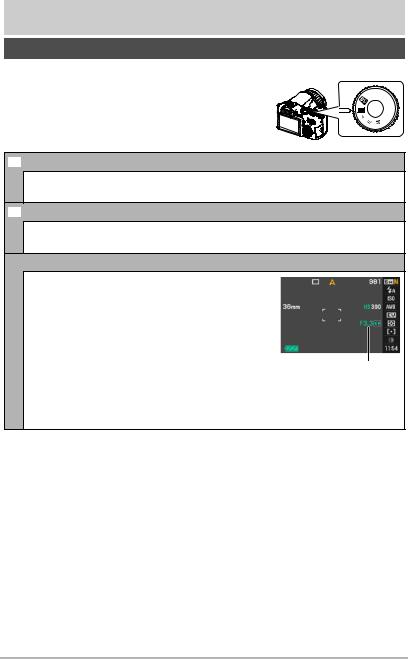
Snapshot Tutorial
Selecting a Recording Mode
Your camera has a variety of different recording |
Mode dial |
modes. Before recording an image, rotate the mode |
|
dial to select the recording mode that suits the type of |
|
image you are trying to record. |
|
t Auto
Use this setting for easy image recording. This is the mode you normally should use (page 18).
b BEST SHOT mode
Simply select one of a collection of built-in sample scenes and the camera sets up automatically for beautiful images every time (page 67).
A A (Aperture Priority) mode
In this mode, you select the aperture and other |
|
settings are adjusted accordingly. |
|
Use [4] and [6] to select the desired aperture |
|
value. |
|
• The ISO sensitivity, shutter speed and aperture |
|
value on the monitor screen will turn orange |
|
when you half-press the shutter button if the |
Aperture value |
image is over-exposed or under-exposed. |
•If you are using manual focus (page 43), you also can press [SET], select “Focus”, and then use [4] and [6] to focus manually.
•You also can adjust aperture and focus using the control dial.
25 |
Snapshot Tutorial |
|
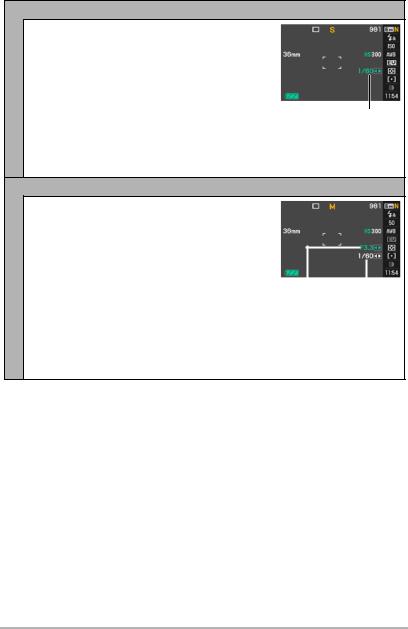
S S (Shutter Speed Priority) mode
In this mode, you select the shutter speed and other settings are adjusted accordingly.
Use [4] and [6] to select the desired shutter speed.
•The ISO sensitivity, shutter speed and aperture value on the monitor screen will turn orange
when you half-press the shutter button if the |
Shutter speed |
image is over-exposed or under-exposed. |
•If you are using manual focus (page 43), you also can press [SET], select “Focus”, and then use [4] and [6] to focus manually.
•You also can adjust shutter speed and focus using the control dial.
M M (Manual Exposure) mode
This mode gives you total control over aperture and |
|
|
|
|
|
shutter speed settings. |
|
|
|
|
|
1Press [SET], select the aperture setting, and |
|
|
|
|
|
|
then use [4] and [6] to change it. |
|
|
|
|
2Press [SET], select the shutter speed setting, |
|
|
|
|
|
|
and then use [4] and [6] to change it. |
|
|
|
|
• |
If you are using manual focus (page 43), you |
|
|
|
|
|
also can press [SET], select “Focus”, and then |
|
|
|
|
|
Aperture value |
|
|||
|
use [4] and [6] to focus manually. |
|
|||
|
|
Shutter speed |
|||
• |
You also can adjust aperture, shutter speed, and |
|
|||
|
|
|
|
||
focus using the control dial.
•The ISO sensitivity, shutter speed and aperture
value on the monitor screen will turn orange when you half-press the shutter button if the image is over-exposed or under-exposed.
26 |
Snapshot Tutorial |
|

 IMPORTANT!
IMPORTANT!
•You may not be able to achieve the brightness you want when shooting an image that is very dark or very bright. If this happens, use the M mode to adjust the aperture or shutter speed manually.
•Due to the characteristics of the camera’s semiconductor, slow shutter speeds can cause digital noise to appear in the image. Because of this, the camera automatically performs a noise reduction process whenever the shutter speed is 1 second or slower. The slower the shutter speed, the greater the possibility that noise will be generated in an image. Because of the time required for noise reduction, the record operation takes longer for images shot at slower shutter speeds. Do not perform any key operation while the image recording operation is in progress.
•Due to the characteristics of the imaging element used by the camera, very fast moving objects in an image may appear distorted.
•Depending on the shutter speed setting and the recording mode you used, the brightness of what appears on the monitor screen when you record the image may be different from the brightness of the recorded image.
•Image AS (page 81) does not work in the S mode and M mode. You can, however, turn on Camera AS, if you like.
•The recording mode changes to t (Auto) automatically whenever you shoot a movie with the “STD” or “HD” movie mode (page 64).
•The aperture, shutter speed, and ISO sensitivity settings configured with the snapshot A Mode, S Mode, or M Mode are used when shooting a movie with the “HS” movie mode (page 64). Note, however, that the shutter speed range is limited in accordance with the frame rate specified for the high-speed movie.
•When recording with some modes, light source flicker can cause horizontal bands to appear in the image.
27 |
Snapshot Tutorial |
|
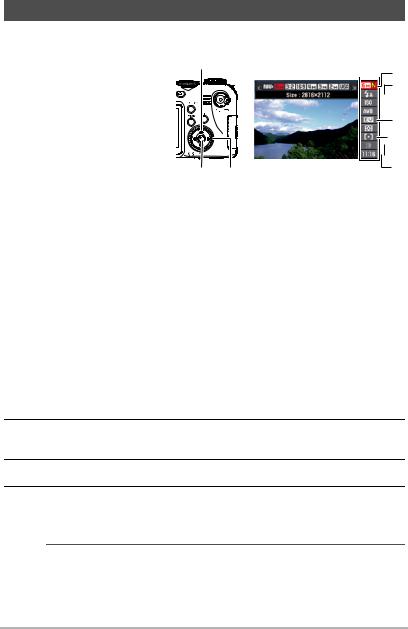
Using the Control Panel
The control panel can be used to configure camera settings.
1. In the REC mode, use [8] [8] [2] [4] [6] and [2] to select the
setting you want to
change.
This will select one of the control panel icons and display its settings.
[SET] Control dial
Control panel
 1 2
1 2 
 3
3  4 5
4 5  6
6 
 7
7 
 8 9
8 9
1Image size/Quality* (pages 29, 87)
2Flash mode (page 31)
3ISO sensitivity (page 34)
4White balance (page 34)
5EV shift (page 36)
6Metering mode (page 37)
7AF area (page 37)
8REC light (Single Shot mode) (page 39)
Continuous shutter (CS) speed (High-speed CS, Prerecord (Still image), Flash CS modes) (pages 48, 50, 52)
Bracketing mode (Bracketing mode) (page 54) View speed (Slow Motion View mode) (page 53)
9Date/Time (page 39)
Prerecord (Still image) Time (Prerecord (Still image) mode) (page 50)
Flash continuous shutter (CS) images (Flash CS mode (with flash)) (page 49) * Image quality cannot be changed using the control panel.
2.Use [4] and [6] to change the setting.
•You also can change this setting using the control dial.
3.If you want to configure another setting, repeat steps 1 and 2.
4.After all of the settings are the way you want, press [SET].
This will apply the settings and return to the REC mode.
 NOTE
NOTE
• You also can configure settings other than those listed above (page 77).
28 |
Snapshot Tutorial |
|
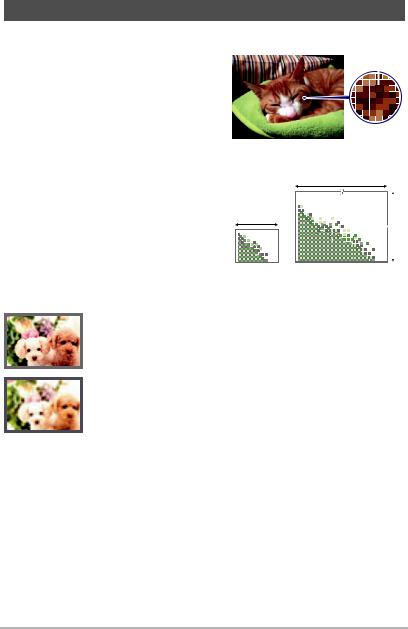
Changing the Image Size (Size)
. Pixels
A digital camera image is a collection of small |
|
|
Pixel |
||
dots called “pixels”. The more pixels there are |
|
|
in an image, the more detail there will be. |
|
|
However, you generally can do with fewer |
|
|
pixels when printing an image (L size) |
|
|
through a print service, attaching an image to |
|
|
e-mail, when viewing the image on a |
|
|
computer, etc. |
|
|
. About image sizes
The size of an image indicates how many pixels it contains, and is expressed as horizontal pixelsxvertical pixels. 12816x2112 size image = Approximately 6
million pixels
2640x480 size image = Approximately
300,000 pixels
Image Size Selection Tips
640
2
480
2816
1
2112
Unit: pixels
Note that larger images have more pixels, so they take up more memory space.
Large Number of Pixels
*More detail, but takes up more memory. Best when you plan to print large-size prints (such as A3 size).
Small Number of Pixels
*Less detail, but takes up less memory. Best when you want to send images by e-mail, etc.
•For information about image size, image quality, and number of images that can be stored, see page 177.
•For information about movie image size, see page 87.
•For information about resizing existing snapshots, see page 113.
29 |
Snapshot Tutorial |
|

. To select the image size
1.In the REC mode, use [8] and [2] to select the top control panel option (Image Size).
2.Use [4] and [6] to select an image size and then press [SET].
Image Size |
Suggested |
Description |
|
Print Size and |
|||
(Pixels) |
|||
Application |
|
||
|
|
||
|
|
Saves the image as both normal JPEG data and |
|
|
|
RAW image data. A 6M size image (2816x2112 |
|
|
|
pixels) is stored for the JPEG data. RAW image |
|
|
|
data is unprocessed data output by the image |
|
|
RAW+JPEG |
sensor and is saved in DNG (digital negative) |
|
|
format. Though the image of such data is virtually |
||
RAW+ |
(Select when |
undeteriorated, it cannot be viewed on the |
|
you want to |
camera’s monitor screen or printed. After |
||
|
process image |
transferring RAW image data to your computer, |
|
|
data yourself.) |
you can use software that supports the general- |
|
|
|
purpose DNG format to process the image and |
|
|
|
convert it to image data that suits your particular |
|
|
|
needs. Since both RAW image data and JPEG |
|
|
|
data are saved by the camera, you can view the |
|
|
|
JPEG version on the camera’s monitor screen. |
|
|
|
|
|
6M |
A3 Print |
|
|
(2816x2112) |
|
||
3:2 |
A3 Print |
Good detail for better clarity even for images |
|
(2816x1872) |
cropped (page 114) from the original |
||
16:9 |
HDTV |
|
|
(2816x1584) |
|
||
4M |
A4 Print |
|
|
(2304x1728) |
Good detail |
||
3M |
A4 Print |
||
|
|||
(2048x1536) |
|
||
2M |
3.5"x5" Print |
Best when preserving memory capacity is |
|
(1600x1200) |
relatively more important than image quality. |
||
|
|||
VGA |
|
Image files are smaller, which is better when |
|
E Mail |
attaching images to e-mail. However, images are |
||
(640x480) |
|||
|
relatively coarser. |
||
|
|
||
|
|
|
30 |
Snapshot Tutorial |
|
